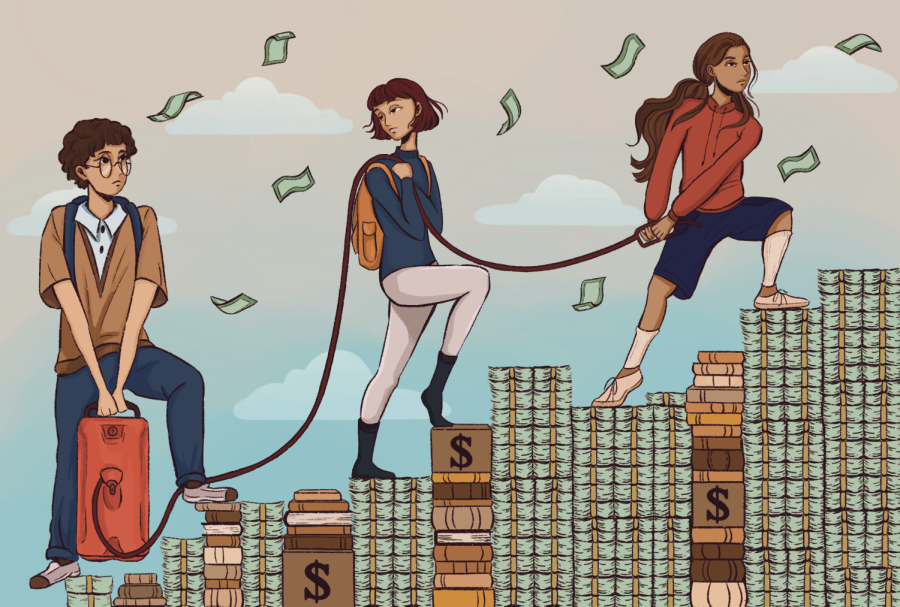Rising inflation is hitting Cal High students hard as well
Illustration courtesy of Susanne Soroushian
Cal High students are among the many Americans struggling to combat rising inflation.
As inflation continues to eat away at many Californians’ wallets, it is clear the overall cost of living in the Golden State has caused stress to many.
And it’s not just adults feeling the pinch. Many Cal High students are struggling to deal with the higher costs of everything from gas to fast food.
“[Gas prices] are pretty high,” junior Abbey West said. “It’s kind of stressful when you have to drive to a lot of places.”
Inflation is the rise in prices of goods and services over a certain period of time.
The United States has an 7.7 percent inflation rate as of Oct. 31, according to the most recent figures released by the US Bureau of Labor Statistics (USBLS).
One way to keep track of the changes caused by inflation is by relying on The Consumer Price Index (CPI) calculated by the USBLS for each region in each of the states.
One of the many major categories of the CPI that affects some high school students directly is transportation. Higher oil prices correlate with increased inflation. In California, energy and gas prices rose by 25.9 percent, according to the USBLS’s Western Office.
This leads to money problems for teens who drive.
“Personally, gas prices have affected me because I am more conscious about my car usage,” senior Aalok Gokarn said. “Going out leisurely requires more of a thought process.”
Teachers who commute large distances to work have the same concerns as students when it comes to filling up a tank.
“I definitely find the increased gas prices a struggle,” English teacher Ashley Tran said. “Usually a whole tank of gas would only cost me about $25-$30, but now it costs me $40+ depending on the station.”
Gas and transportation aren’t the only pressing costs for San Ramon residents.
The cost of essentials like food in San Ramon is 28 percent higher than the national average. The USBLS’s Western Office reporter that food prices have seen a drastic increase of 10 percent this year, compared to years past when the increase was closer to 5 percent.
Students have noticed this increase in prices as well.
“Even though prices have been increasing, I am not really seeing an increase in portion sizes,” junior Rishi Pagadala said. “Rather than increasing it [portion sizes], they are actually decreasing.”
With a higher demand for goods and the services that come with them, many businesses require more labor. Firms have had to offer more attractive wages to hire more employees.
To adapt to a higher cost of living and to aid the financial stability of families in California, Gov. Gavin Newsom announced that California’s new hourly minimum wage will be $15.50 starting in 2023.
This increase in the baseline wage affects students since many work minimum wage jobs. Now that they will make a little more, students have more spending money in their wallets.
“The minimum wage has been really low for a very long time,” junior Nica Majlesi said. “And with all these [gas and food] prices going up, people are not able to supply food for their families, so it’s nice that there is a higher wage.”
Other students have differing opinions on the increased baseline for minimum wage in California.
“I feel like the state minimum wage going up because of inflation is necessary,” junior Ada Wang said. “But it is still nowhere near enough to meet the cost of living in California outside of basic necessities.”
In addition to rises in costs of transportation and food essentials, another pressing cost for San Ramon residents is housing.
San Ramon is in the top 4 percent of the most expensive cities in the world and the housing expenses here are 253 percent higher than the national average, according to USBLS data. San Ramon housing prices increased 6.2 percent over the past year alone.
“[The cost of living] is starting to get really out of hand,” Wang said. “And if trends continue going like this, from my point of view, I don’t know how many people will be able to keep living here.”
Inflation has compressed housing budgets for many, with most people have little to no power when it comes to making their purchases.
“With the increasing cost of living in California, I’m not sure if/when I’d be able to afford moving out and living on my own,” Tran said.

Junior Mansi Swaminathan is returning for her third year with The Californian, now as Managing Editor. Her main goals for the paper this year are to get...








